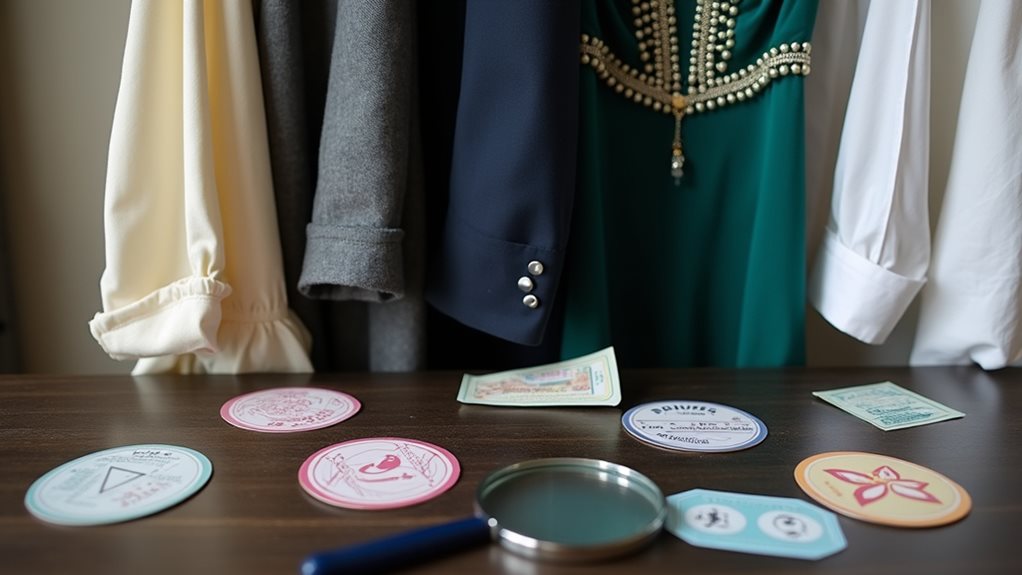You’ll definitely need dry cleaning for anything labeled “dry clean only,” like those gorgeous silk blouses or structured blazers that make you feel unstoppable, but honestly, I’ve learned the hard way that many garments can survive gentle home washing with the right approach. Cotton shirts, polyester pieces, and even some modern wool items can handle your washing machine just fine, though I always recommend doing a sneaky spot test first since nobody wants to turn their favorite sweater into doll clothes! Understanding these distinctions will save you both money and heartache.
Understanding When Dry Cleaning Is Essential
While most of us can toss our everyday clothes into the washing machine without a second thought, there are certain moments when you’ll find yourself standing in your closet, holding a garment and wondering if it needs the professional touch of dry cleaning.
Trust me, I’ve been there, clutching my favorite silk blouse like it’s a fragile butterfly, knowing one wrong move could spell disaster.
Dry cleaning is ideal for those “dry clean only” labels you’ll spot on delicate fabrics like cashmere, silk, and structured blazers—basically anything that makes you feel fancy but also slightly terrified.
Those fancy fabrics that make your wallet weep and your heart race? Yeah, they definitely need the professional treatment.
When your garments have intricate beading, stubborn stains, or you’re preparing for that important presentation, professional care guarantees everything stays pristine.
Unlike traditional washing methods that can cause shrinkage and color bleeding, dry cleaning uses chemical solvents instead of water to safely preserve your fabric’s integrity and appearance.
Decoding Care Labels and Fabric Requirements
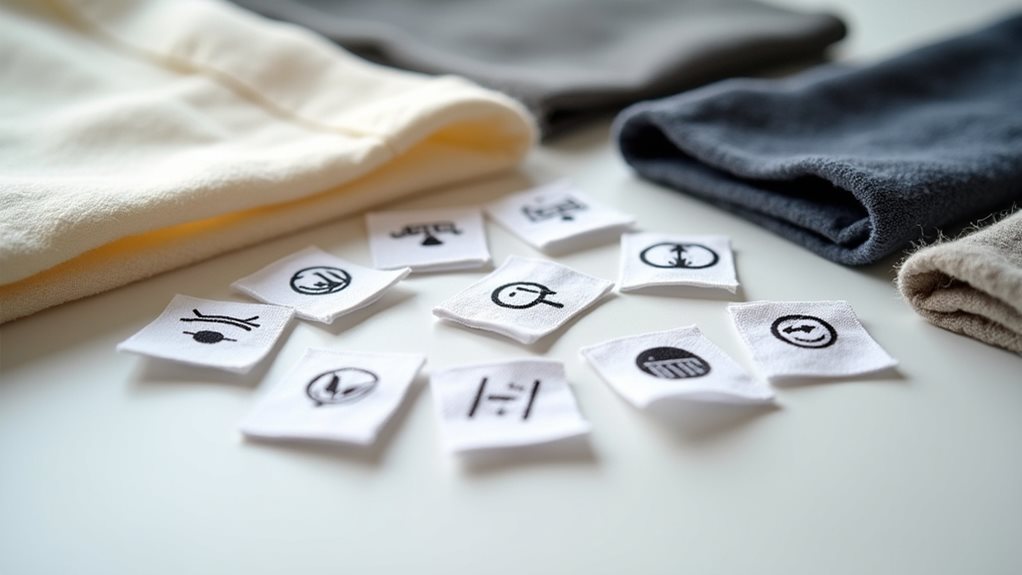
When you’re standing in your closet holding that gorgeous silk blouse you splurged on last month, those tiny symbols on the care label might look like ancient hieroglyphics, but they’re actually your clothing’s survival guide.
I learned this the hard way when I tossed my favorite cashmere sweater into the washing machine without checking the tag first – let’s just say it now fits my nephew’s teddy bear perfectly 😅.
Understanding these fabric requirements and symbols isn’t just about following rules, it’s about protecting your investment and keeping your clothes looking fresh for years to come.
The circle-based symbol system on your garment labels uses specific markings like letters P, F, or W to indicate which solvents are safe for professional cleaning, while bars underneath signal when gentler treatment is required.
Reading Care Tag Symbols
How many times have you stared at those cryptic little symbols on your clothing tags, feeling like you’re trying to decode ancient hieroglyphics while standing in your laundry room? 😅
I’ll admit, I spent years ignoring those tiny icons completely, tossing everything into the washing machine with reckless abandon until I shrunk my favorite cashmere sweater into what could’ve been a stylish outfit for my nephew’s teddy bear.
Learning to read your care label symbols is like having a secret conversation with your clothes, where they’re literally telling you exactly what they need to stay beautiful.
That circle symbol means dry cleaning, while the tub icon indicates machine washing is safe. When you see delicate fabrics like silk or wool, those symbols become your roadmap to preserving their luxury and longevity.
It’s important to distinguish between “dry clean recommended” and “dry clean only” labels, as the former indicates the garment can be safely dry cleaned but doesn’t necessarily require it, unlike the latter which mandates professional cleaning.
Fabric Type Guidelines
Since different fabrics have personalities as distinct as your friends, understanding what makes each one tick will save you from countless wardrobe disasters and expensive replacement shopping trips.
Your silk blouse and cashmere sweater are the high-maintenance friends who need special attention—they’ll shrink, fade, or lose their luxurious feel if you toss them in your washing machine like yesterday’s gym clothes. When you see “dry clean only” on care instructions, think of it as a non-negotiable boundary that’ll keep your investment pieces looking stunning for years.
Meanwhile, your trusty cotton tees and polyester work shirts are the easygoing buddies who can handle your home washer’s enthusiastic cycles. A good dry cleaner becomes your fabric whisperer for delicate vintage finds.
The dry cleaning process uses chemical solvents instead of water, making it particularly effective at removing oil-based stains while preventing the shrinkage and color bleeding that can occur with traditional washing methods.
Dry Clean Only Requirements
Although that tiny care label tucked inside your collar might seem like fashion industry fine print, it’s actually your garment’s survival manual written in a secret code that’ll either save your favorite pieces or doom them to closet exile.
When you spot “dry clean only” on a label, that’s not a suggestion—it’s a firm boundary your garment is setting, and trust me, you don’t want to cross it. This strict garment care requirement typically appears on delicate fabrics like silk, wool, and cashmere, where water would wreak havoc on their fibers, causing shrinkage, color bleeding, or complete structural breakdown.
Unlike labels that simply say “dry clean” (which gives you wiggle room), the “only” makes it non-negotiable for preserving your investment. Structured clothing like suits and blazers also require dry cleaning to maintain their professional shape and tailored fit that would be lost in traditional washing machines.
Garments That Always Require Professional Cleaning
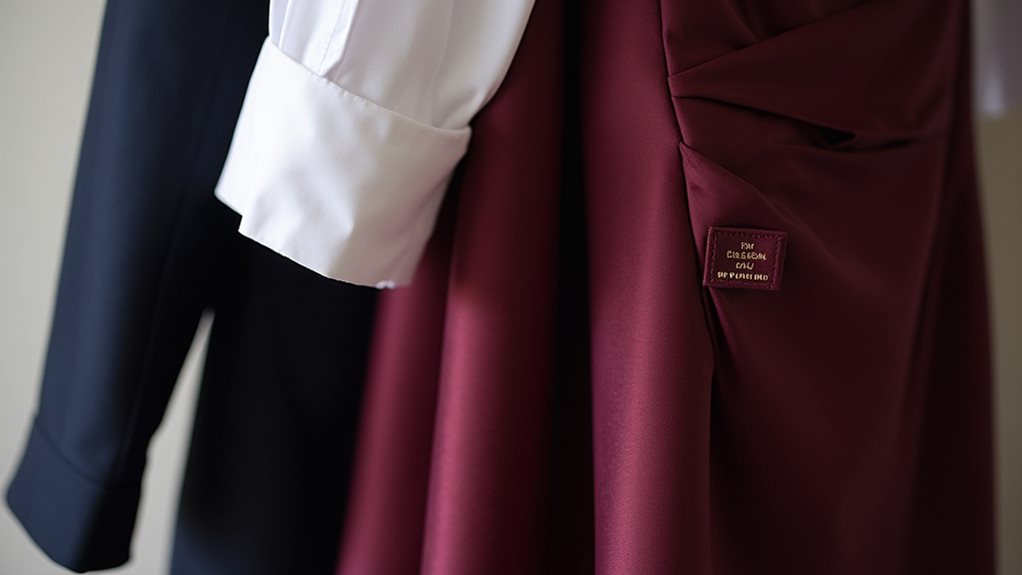
When you’re staring at that gorgeous silk blouse with the “dry clean only” label, trust me, I’ve learned the hard way that ignoring those three little words can turn your favorite piece into an expensive lesson in fabric chemistry.
Three little words on a care label can save you from turning your wardrobe’s crown jewel into an expensive mistake.
Your delicate garments deserve the expertise that only professional dry cleaners can provide, especially when we’re talking about structured wool suits, vintage treasures, and anything made from cashmere or velvet.
I once watched a friend’s grandmother’s lace dress literally fall apart after a well-meaning home wash attempt – heartbreaking doesn’t even cover it.
Evening gowns with beading, custom blazers, and tuxedos aren’t just clothing; they’re investments that require professional care to maintain their elegance and longevity.
Professional dry cleaners use specialized chemical solvents instead of water to safely remove stains and dirt while preserving the integrity of these sensitive fabrics and their intricate construction details.
Items You Can Safely Wash at Home Instead

While I’ve definitely fallen into the trap of overthinking laundry care labels, the truth is that many items sitting in your closet right now can skip the expensive dry cleaning trip and get perfectly clean in your own washing machine.
Your cotton dress shirts, linen pants, and polyester blouses are all perfectly safe for home washing – just stick to cold water and you’ll be golden. Modern wool pieces can often handle machine washing too, though I always double-check vintage pieces first.
Even your precious cashmere sweaters can be rescued with a gentle hand wash using mild detergent, saving you serious cash while keeping that luxurious softness intact.
Before attempting any alternative cleaning method, always test on an inconspicuous area first to ensure the fabric won’t be damaged or discolored.
Trust me, your wallet will thank you!
Performing Spot Tests Before Making Your Decision
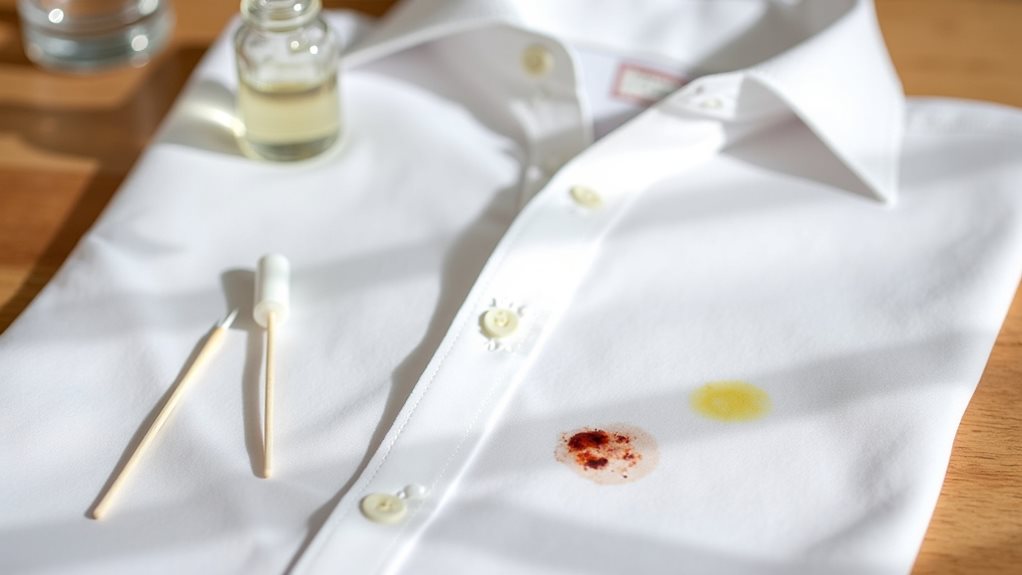
Before you toss that questionable garment into your washing machine or march it straight to the dry cleaner, there’s one essential step that could save you from a fashion disaster – and I learned this the hard way after turning a gorgeous burgundy blouse into a tie-dye nightmare.
Always perform a spot test first by applying mild detergent to a hidden seam, checking for colorfastness before making your washing decision. If dye bleeds during testing, choose professional dry cleaning instead of risking fabric damage.
This technique proves especially important for vibrant colors, intricate patterns, and delicate fabrics that’re more prone to dye transfer.
Skip harsh bleach during testing, address any stains promptly, and you’ll confidently choose the safest cleaning method. For oil-based stains specifically, dry cleaning uses chemical solvents that dissolve oils more effectively than water-based washing methods.
Comparing Costs and Benefits of Each Method

After years of cringing at my credit card statements and wondering why my favorite cashmere sweater looked better than my bank account felt, I’ve learned that understanding the true cost-benefit equation between dry cleaning and home washing goes far beyond those initial price tags.
While spending $15-30 per garment feels painful upfront, those items I’ve consistently dry cleaned have genuinely lasted years longer than similar pieces I’ve tossed in my washer.
The sticker shock hurts initially, but my dry-cleaned pieces consistently outlast their machine-washed counterparts by years.
Home care costs mere dollars per load, but you’re trading convenience and specialized stain removal for potential fabric damage.
The environmental factor weighs heavily too – those chemical solvents aren’t exactly earth-friendly, though eco-friendly home detergents can minimize your footprint while maintaining proper garment care.
Dry cleaning’s specialized solvents excel at removing oil-based stains and grease that water-based washing simply can’t tackle as effectively.
Special Considerations for Delicate Materials
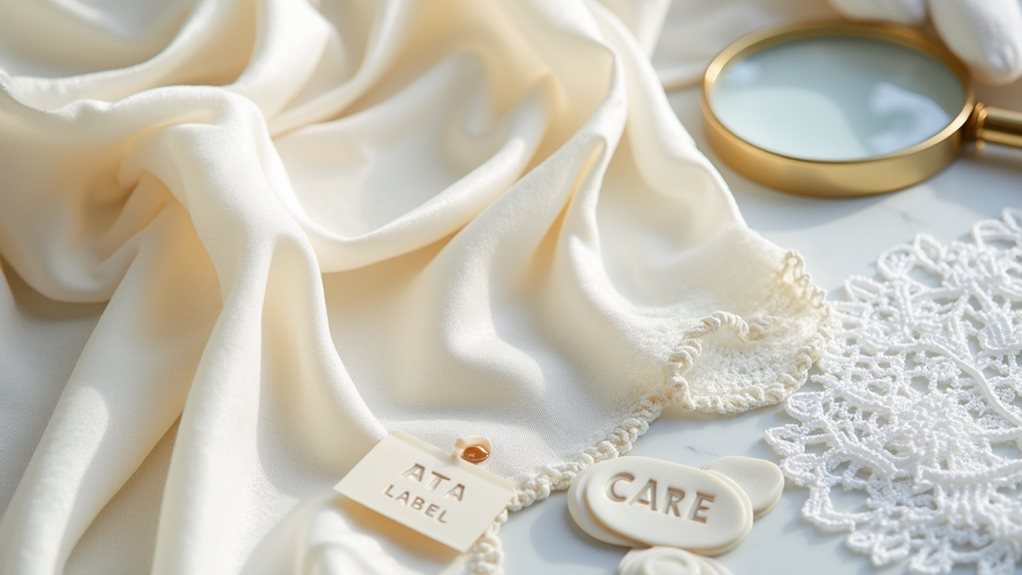
When you’re standing in your closet holding that gorgeous cashmere sweater your grandmother gave you, the fabric type becomes everything—because one wrong move in the washing machine, and you’ll have an expensive dish towel on your hands.
You’ll need to assess whether your delicate pieces can handle gentle home cleaning methods, or if they’re the type that demand professional attention to keep their beauty intact.
I learned this lesson the hard way when I hand-washed a vintage silk blouse that seemed sturdy enough, only to watch the dye bleed into a murky mess that would’ve made a tie-dye artist weep 😅.
Dry cleaning uses chemical solvents instead of water to remove dirt and stains while preserving the fabric’s original texture, shape, and color integrity.
Fabric Type Assessment
Something magical happens when you run your fingers across a piece of pure silk or cashmere – there’s an undeniable luxuriousness that makes you want to protect it at all costs.
Honestly, that instinct is spot-on because these delicate darlings need special care that goes way beyond tossing them in your washing machine with your everyday cotton tees.
When you’re doing a proper fabric type assessment, look for those telltale care labels that whisper “dry clean only” – they’re basically your fabric’s way of saying “handle with care, please!”
Wool, silk, and embellished pieces aren’t being dramatic; water can literally destroy their structure, cause shrinkage, or make colors bleed faster than a guilty toddler confessing to crayon wall art.
Gentle Cleaning Methods
While dry cleaning might seem like the safest bet for your precious delicates, there’s actually a whole world of gentle cleaning methods that can keep your silk blouses and cashmere sweaters looking fabulous without breaking the bank or exposing them to harsh chemicals.
Trust me, I learned this after ruining my favorite cashmere cardigan at the cleaners! For silk pieces, use a mild detergent with tepid water and hang them to dry—never throw them in the dryer unless you want expensive washcloths.
Cashmere actually prefers hand washing over dry cleaning, while wool can often handle gentle machine cycles. Always spot test first, because nothing’s worse than watching your favorite sweater turn tie-dye before your eyes! 😅
Choosing the Right Cleaning Method for Your Wardrobe
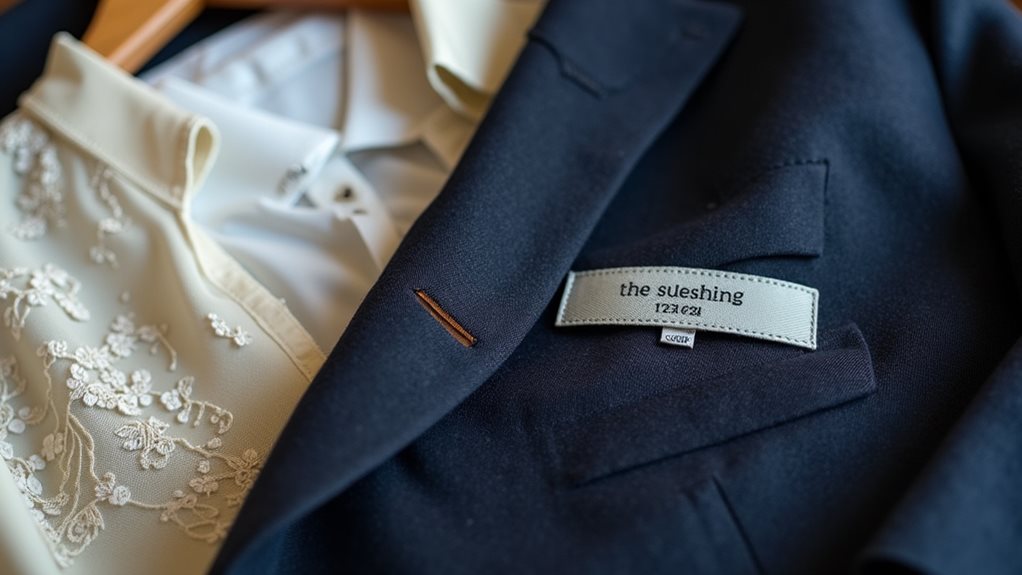
How many times have you stood in your closet, holding a garment and wondering whether it needs the expensive dry cleaning treatment or if you can safely toss it in your washing machine at home?
I’ve been there countless times, squinting at tiny care labels like they’re ancient hieroglyphics 🔍.
Here’s my foolproof approach: always respect the “dry clean only” label—manufacturers aren’t trying to drain your wallet, they’re protecting your investment.
Trust the care label—it’s your garment’s insurance policy, not a conspiracy against your bank account.
Delicate fabrics like silk, cashmere, and wool genuinely need professional care to maintain their luxurious feel and structure.
However, sturdy cotton, linen, and polyester pieces can handle your home washing routine beautifully.
When in doubt, consider the garment’s value, both sentimental and financial, then choose accordingly.

